Physics 2
Two charged plates are set up as pictured below. A charged ball of mass m and charge q is to be thrown between the plates with initial velocity V. The ball is a vertical distance, d, from either of the plates. Find how far down range the ball travels.
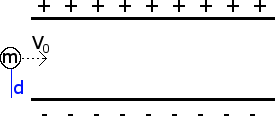
A charged ball of mass m and charge Q is hung from a mass less pendulum. A uniform electric field along the horizontal causes the pendulum to swing up an angle . Find the magnitude of the electric field.

A proton ( 1.6 x 10 C ) is placed 2.19 x 10 m from point A. Find the electric field at point A. Imagine a proton is put at point A. Find the force that acts on the proton.
A +12 nC charge is distributed uniformly along the y-axis from y = 0 to y = 4.0 m. What is the x-competent of the electric field at x = 2.0 m on the x-axis? (this type of problem may not be covered in algebra based physics courses)
A +1 nC charge is placed at the origin, < 0 , 0 > . Find the electric field at point x = < 0.2 , -0.4 > (this type of problem may not be covered in algebra based physics courses)
Two point charges are attached by a weightless pole and placed into an electric field, as shown below. Find the torque due to the electric field, E = 4 N/C.
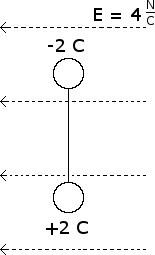
Two parallel charged plates, one with a surface charge density of = 40 and another, = -60 . Find the total electric field between the plates. (note this is not a capacitor)
An electron is released from rest at the surface of a very large plate of charge density -50 . How long will it take for the charge to move 10 cm?
The electron gun in a television tube is used to accelerate electrons from rest to 3.0 x 10 m/s within a distance of 2.0 cm. What electric field is required? Should the electric field be in the same or opposite direction of the electrons motion?
What electric field (magnitude and direction) is needed to levitate a proton?m = 1.67 x 10 kg
The figure below shows a single dipole of charges 5 nC, with a distance s = 0.002 m between the poles. Point A is a distance, d = 0.1 m, and is perpendicular to the dipole. Point B is a vertical distance, d = 0.1 m, and is parallel to the dipole. Find the electric field at points A and B.
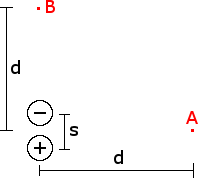
Two dipoles are placed a distance, d = 0.05 m, from the point A (labeled in red). The distance between dipoles is s = 0.01 m. Each dipole consists of a positive and negative charge of 2 nC. Find the electric field at point A.
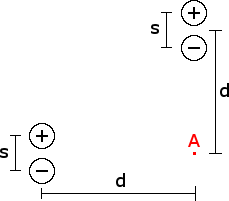
Point A is a distance d = 0.5 m from the center of a charged rod. The rod has a charge of + 1 nC and is X = 4 m long. Find the electric field at point A.
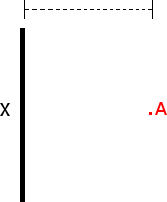
The rod below is 1.4 m long and carries a charge of -8 x 10. Point A is 0.7 m from the center of the rod. Find the electric field at point A due to the bottom 1/8th of the rod, colored blue below.
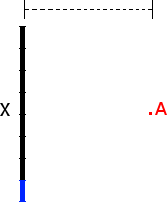
Two concentric loops are shown below, with a distance between them Y = 0.4 m, a radius Z = 0.1 m. The loop on the left has a charge of +9 nC and the loop on the right has a charge of -9 nC. Find the electric field at point X, which is directly in the middle of the loops.

A disk with radius R = 0.4 m carries a +4 C. Find the electric field at point X, a distance of 0.001 m from the center of the disk.

Below are two charged spheres separated by a distance, X = 0.1 m from center to center. The sphere on the left carries a charge of 10 nC and has a radius 0.01 m. The sphere on the right carries a charge of -2 nC. Find the electric field at point A, which is 0.005 m from the center of the large sphere.

Given the 3 dimensional electric field, = 200 + 300 + 400 , and an area vector = 0.2 m + 0.3 m , find the electric flux. (this is a calculus based physics problem)
Below is a figure depicting a uniform electric field, E = 400 N/C at an angle = 40 above the horizontal. The red line represents a rectangle, going into the page, with area, A = 0.20 m. Find the electric flux through the rectangle.

A uniformly charged sphere has a radius of 40 cm and a total charge of 80 nC spread throughout its volume. If the following sections were removed from the sphere, how much charge would they contain?
A. A Spherical section with a radius of 10 cm
B. A cubical section with sides of 5.0 cm
C. A cylindrical section with radius 8.0 cm and length 15 cm